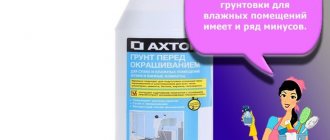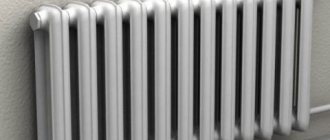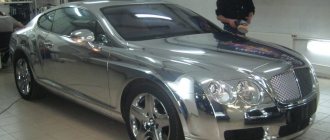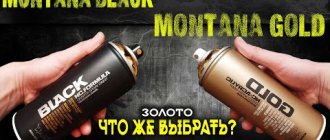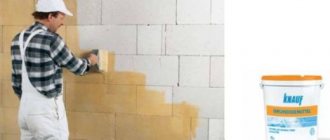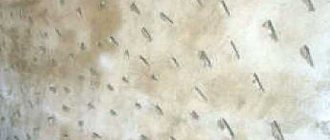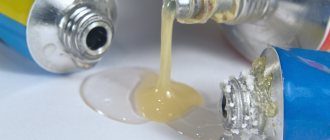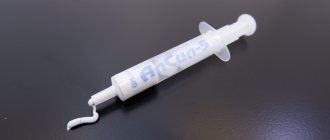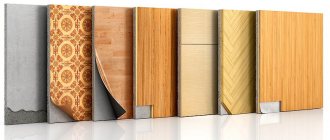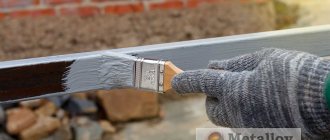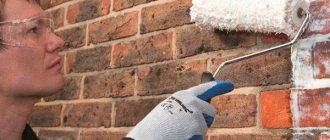Alkyd primer: composition and properties of the material
Alkyd primers consist of the following components:
- synthetic resin;
- alkyd varnish;
- driers;
- solvents;
- stabilizers.
The basis of this primer is resin, which does not contain film-forming additives and substances that squeeze air out of the materials being processed.
Alkyd mixtures use more volatile solvents than paint. Due to this, such soils become liquid. The mixture also contains vegetable oils, which provide better permeability of the material, including into contaminated surfaces.
Depending on the type of components that such soils include, the latter acquire the following characteristics:
- anti-corrosion resistance;
- resistance to temperature changes in the range from -40 to +40 degrees;
- reduce the consumption of paints and varnishes;
- fill small gaps and cracks, creating additional protection from mechanical stress;
- prevent the formation of mold and mildew;
- increase the service life of wood.
Alkyd primers are universal. These compounds can be used to process various materials. However, these soils cannot be used to treat crumbling surfaces: plaster, gypsum and others. This recommendation does not apply to concrete.
Peculiarities
Since alkyd primers are universal, they have gained great popularity in our country. These primers can be used on metal, wood, concrete, plastic, and even glass. Depending on what material the primer is applied to, it performs the following functions:
- protects against corrosion and rusting;
- increases the adhesion rate (adhesion of the finish to the base);
- reduces the consumption of paint and varnish products by filling all pores and cracks;
- makes the surface of the material more durable, so the finishing paint or putty applied over the alkyd primer will not flake off, peel or fall off;
- increases the water resistance of wood materials; after applying the primer, the wood practically does not swell or shrink;
- provides antiseptic protection, so that fungi and mold do not settle on the surface;
- increases resistance to the negative influence of the environment and various aggressive chemical compounds;
- increases the resistance of the material to abrasion;
- protects the paintwork from the appearance of resinous substances.
Operating principle and scope
The principle of operation of the material is based on an insulating protection mechanism. This composition, applied to the car body or other surfaces, dries quickly, forming a durable film. Iron oxides included in the mixture are responsible for the formation of the latter. This film prevents moisture and air from penetrating the surface.
The scope of application of alkyd primers, as noted above, is not limited to metal or wood. This composition is suitable for treating surfaces on industrial sites, automobile bodies, concrete and other structures. By combining primer and alkyd paints, you can significantly increase the service life of wooden products.
See also
Technical characteristics of the primer Betonkontakt ST-19 from Ceresit
This composition is used as a base for various finishing materials. In particular, in addition to paints, liquid wallpaper, putty, and more can be applied over alkyd primers.
Application
Alkyd-based primer is used for processing any metal and wooden products, for example, car bodies, frame wooden buildings and houses, as well as for protecting various boards, such as chipboard, OSB, and others. After the primer has dried, it can be primed and some other finishing applied, for example, paint, varnish, etc.
In addition, an alkyd-based primer has another important feature - the polymers included in its composition, after drying, form a high-strength surface film that is sufficiently resistant to adverse factors and environmental influences. Therefore, a mixture, for example, otex tikkurila alkyd primer, can be used during interior and exterior work. Many compositions, including otex tikkurila, can be tinted in any color.
Advantages and disadvantages of the material
Alkyd primers have the following advantages:
- characterized by high strength and elasticity;
- increased resistance to abrasion after curing;
- hide resinous knots on wood;
- Various dyes and adhesives can be placed on top of the material;
- wide scope of application;
- you can treat surfaces at subzero temperatures (provided that the container with the mixture is indoors);
- minimal toxin content.
At the same time, alkyd primers, in comparison with other similar mixtures, have the following disadvantages:
- long drying period (because of this, it is necessary to ensure high-quality ventilation in the room);
- Before applying paint, you must wait until the primer has completely dried (otherwise the material will curl up upon contact);
- not suitable for treating porous surfaces (the primer does not penetrate deeply into the structure of the material);
- not suitable for finishing synthetic materials;
- the presence of a specific odor.
After working with such a primer, the tools used must be washed with solvents such as white spirit. Water does not wash away the material from the surface due to the dense protective film.
What is a primer?
Alkyd primers represent a number of the most popular types of primer mixtures that are used in the repair of objects for any purpose. The demand for the compositions is very stable and high, which is achieved due to the positive characteristics and versatility of the mixture.
The primer can be used to treat various surfaces, from metal to plastic, wood and even glass.
The primer mixture provides excellent surface protection and also creates the basis for optimal coverage with facing materials. Despite the popularity of the composition, the product has both positive characteristics and negative features, which will be discussed further.
See also: all types of primers for metal
Advantages
The positive features of alkyd primers are as follows:
- The highest soil strength;
- Absolutely resistant to abrasion after the mixture has dried;
- Excellent hiding of resinous knots. They do not disturb the eyes even several years after treatment;
- Paints of any type (enamel, acrylic, etc.) as well as various types of glue (universal, wallpaper and PVA) fit perfectly onto the primer. Putty can also be applied to the surface;
- Many packages and cans indicate metal. However, the mixture is excellent for treating any other surfaces (plastic, wood, laminate, plaster, etc.);
- The ability to use the composition even at subzero temperatures, using basic methods to ensure the effectiveness of the mixture;
- Worker-friendly composition that has a minimal amount of toxins. Despite recommendations regarding the use of special safety equipment (masks, gloves, etc.), performing work without them will not pose any harm to health. Also, the time to ventilate the room after work is significantly reduced in comparison with soils based on other components.
Thanks to these advantages, the mixture has gained a foothold in the modern market for a long time, and is also popular in many areas of construction activity.
Flaws
Despite the impressive list of advantages, primer based on alkyd components has the following negative features:
- Drying takes a long time, so it is important to create optimal conditions with good ventilation;
- Upon contact with the mixture, some paints may curl, because some soil characteristics are activated only after drying;
- Only the top ball of the surface can be processed. The product does not penetrate into the depth of the material, therefore it cannot be used for fastening loose surfaces. In such cases, acrylic-based primers should be used;
- The mixture cannot be used for processing synthetic materials, because they may bubble and stretch significantly;
- Despite the minimal list of toxic substances in the primer, the mixture has a specific odor, so it is better to thoroughly ventilate the room;
- Tools used to work with alkyd primer are difficult to wash with plain water. It is necessary to use white alcohol, and also try to isolate brushes and rollers from air to avoid drying out.
Despite these disadvantages, alkyd primers are rightfully considered a popular means for primary surface treatment. If you use the mixture correctly, its characteristics and features will speed up work and improve the quality of surfaces.
Where is it used?
Alkyd primers can be used in repair and finishing work to treat various types of surfaces to ensure resistance to moisture and other biological and chemical influences.
Using the mixture will protect the surface from the formation of rust and fungus.
Also, treatment with alkyd compounds makes it possible to significantly strengthen the surface of an object and fill its pores and crevices, which will allow the use of less materials for finishing.
Alkyd primer mixtures are used in the following types of work:
- For processing wood, OSB and chipboard before finishing painting;
- For covering walls before applying wallpaper or putty;
- For processing metal before applying finishing paint.
The use of primer ensures a high level of adhesion between all balls of the finished surface. The external coating will have impressive resistance to mechanical, chemical and biological influences, which is important when treating surfaces that are located outdoors.
What are the varieties and recommendations for choosing
As noted above, the characteristics and scope of application of alkyd primer mixtures are determined by the additional components included in the material. Based on this feature, this product is divided into 7 types.
Alkyd-acrylic
This type of primer combines the characteristics of two materials (acrylic and alkyd resins), due to which the material penetrates deeply into the surface being treated, thus increasing the level of protection.
These compositions can be applied to porous and loose substrates, including external walls. The primer also provides anti-corrosion protection and dries quickly: at temperatures above +20 degrees the process takes less than an hour.
Alkyd-urethane
In addition to these components, such mixtures contain additional substances that increase the strength characteristics of the soil. The material is used mainly for processing wood and metal. Thanks to the urethane base, the mixture can be used for finishing surfaces at temperatures down to -45 degrees.
However, alkyd-urethane primers cannot be applied to a loose or crumbling base. In particular, it is prohibited to process gypsum plaster. But this mixture is considered optimal when there is a need to create a protective layer under the glue.
Glyphthalic
In addition to alkyd resin, this primer contains glycine and pigments, which give the material a certain shade. This type of protective mixture is also versatile. Glypthal primers can be used to treat various surfaces.
See also
Technical characteristics of enamel OS-51-03, consumption and rules of application
For wood
The composition of primers intended for wood processing includes components that prevent the release of resin. These materials also warn:
- the appearance of mold and mildew;
- wood rotting;
- the appearance of pests.
At the same time, the mixture increases the adhesion of applied paints and varnishes.
Perchlorovinyl
Perchlorovinyl also contains coloring pigments. This composition emits a pungent odor, so the primer is used for external work. The advantages of this mixture include the ability to penetrate rust and remove it. Thanks to this feature, the material can be applied to unprepared metal.
Compared to other primers, perchlorovinyl is characterized by increased resistance to aggressive influences. The material dries quickly at a temperature of +20 degrees.
For metal
Metal primers provide anti-corrosion protection by creating a moisture-proof layer. The mixture acquires such characteristics due to the inclusion of zinc phosphate in the composition. These primers are available both in standard containers and in aerosol form, making application easier.
Universal
Universal alkyd primers contain zinc chromate, thanks to which the mixture can be applied to almost any surface. Specified substance:
- increases film strength;
- improves protective properties;
- makes the film resistant to ultraviolet exposure;
- increases the strength of the soil to the effects of negative temperatures.
Universal alkyd primers are used for interior and exterior work.
Alkyd primer: types, characteristics and application
Before performing any finishing or painting work, you need to coat the base with a primer. Thanks to priming, the service life of any surface is extended, and the need for further repairs is postponed. This article will discuss alkyd primer, its properties, main types and application rules.
We recommend: Types of primers
Peculiarities
Since alkyd primers are universal, they have gained great popularity in our country. These primers can be used on metal, wood, concrete, plastic, and even glass. Depending on what material the primer is applied to, it performs the following functions:
- protects against corrosion and rusting;
- increases the adhesion rate (adhesion of the finish to the base);
- reduces the consumption of paint and varnish products by filling all pores and cracks;
- makes the surface of the material more durable, so the finishing paint or putty applied over the alkyd primer will not flake off, peel or fall off;
- increases the water resistance of wood materials; after applying the primer, the wood practically does not swell or shrink;
- provides antiseptic protection, so that fungi and mold do not settle on the surface;
- increases resistance to the negative influence of the environment and various aggressive chemical compounds;
- increases the resistance of the material to abrasion;
- protects the paintwork from the appearance of resinous substances.
Application
Baba Nina: “Poverty will go away! Just keep the usual one in the corner of the house...”
Alkyd-based primer is used for processing any metal and wooden products, for example, car bodies, frame wooden buildings and houses, as well as for protecting various boards, such as chipboard, OSB, and others. After the primer has dried, it can be primed and some other finishing applied, for example, paint, varnish, etc.
In addition, an alkyd-based primer has another important feature - the polymers included in its composition, after drying, form a high-strength surface film that is sufficiently resistant to adverse factors and environmental influences. Therefore, a mixture, for example, otex tikkurila alkyd primer, can be used during interior and exterior work. Many compositions, including otex tikkurila, can be tinted in any color.
Differences from acrylic primers
The joints will become young again and stop hurting if...”
Some people are wondering what is better to choose – acrylic or alkyd primer? These compounds have different purposes. An alkyd primer is mainly used for wood and metal; subsequently, the surfaces can be puttied or treated with paints and varnishes.
And acrylic primers are most often used for application to mineral porous substrates such as concrete, drywall, brick, plaster and putty. However, there are acrylic anti-rust primers for metal, and protective primers for wood.
Their main advantages are the complete absence of odors and fast drying time.
However, alkyd primer for metal and wood is a more popular and sought-after product, since its cost is much lower compared to acrylic materials, and the performance characteristics are almost the same, with the only exception being environmental friendliness and safety for humans.
Types of alkyd primers
Alkyd-based primers are a large group of primer products, including several types of mixtures that have different performance characteristics, applications and properties. The most common primers are:
- glyphthalic;
- perchlorovinyl;
- alkyd-urethane;
- alkyd-acrylic.
The properties and applications of each of these types of mixtures will be discussed in detail below.
HUNT EXPERT – high-quality bait for artiodactyl animals
Glypthal primers
These compositions are made from alkyd varnish, to which various pigments, stabilizers and driers are added.
Thanks to pigments, you can enhance the shade after painting, but in this case you need to choose a primer that matches the color.
If you don't think about the shade in advance, you can ruin the shade of the paint you apply, especially if the paint doesn't cover the primer well.
We recommend: Epoxy primer in a can: we describe all the nuances
Main characteristics of glyphthalic alkyd primers:
- can be applied to ferrous and non-ferrous metals, wood;
- used when performing external and internal work;
- create a thin and durable film on the base that has anti-corrosion protective properties;
- dry in about 24 hours if the air temperature is about 20 degrees.
One of the most common glypthal primers is GF-021, which is a universal primer. There are universal glypthal mixtures on sale that are suitable for processing wood and metals, and there are also compositions only for metal surfaces, so when choosing a primer, you must take into account its purpose.
Attention! Many paints and varnishes curdle when they come into contact with a glyphthalic primer that has not completely dried, so you need to wait until the alkyd mixture has completely polymerized before proceeding with finishing.
Perchlorovinyl primers
These solutions are a mixture of alkyd varnish, several fillers and pigments. This type of alkyd composition is the most versatile because it can coat almost all types of surfaces, including plaster and concrete bases. Main characteristics of perchlorovinyl alkyd primers:
- the compositions are very toxic and harmful to human health, so they can only be applied outside, in the open air;
- you can apply this alkyd primer directly to the rust; only those brands of perchlorovinyl solutions that contain a special modifier, for example, orthophosphoric acid, which converts iron oxide into a protective layer of metal, have this option;
- dry out very quickly. How long does it take for perchlorovinyl mixture to dry? If the air temperature is about 20 degrees, then the composition dries completely on the surface in about an hour;
- resistant to aggressive chemical solutions, including acids, alkalis and gases.
This type of primer is more expensive compared to alkyd glyphthalic solutions.
Alkyd-urethane mixtures
These primers are made from alkyd-urethane varnish, drier, special fillers and pigment. These primer solutions are a modification of the alkyd mixture, in which phthalic anhydride is partially replaced by a special isocyanate.
This modification gives these compositions the following advantages:
- After drying, the protective layer acquires an increased hardness index, it is very resistant to mechanical influence and damage;
- has excellent wear resistance and resistance to external conditions;
- very fast polymerization process. Many people are interested in how long it takes for this type of alkyd primer to dry? It dries in about half an hour;
- can be used indoors and outdoors, for processing various metals and wood, alkyd-urethane compounds are universal.
Due to its high performance properties and versatility, this type is often used in the field of mechanical engineering, for processing car bodies and all kinds of parts.
Alkyd-acrylic primers
Nowadays, this type of composition is very often used to improve the performance of metal and wooden products.
These primers significantly improve the adhesion of paints and varnishes, and are also used as independent impregnations for wooden structures.
These alkyd solutions protect wood from mold, rot, and other harmful effects of the atmosphere and microflora. The main features of these mixtures are the following:
- penetrate very deeply into the wood;
- are made on a water basis, so the solutions have no odor;
- when processing metals, they provide high-quality and durable protection against rust;
- dry within 1 hour, at an air temperature of 23 degrees.
Application of primer
Before applying alkyd primers, the surface must be thoroughly prepared. Metal bases must be cleaned of rust and sanded. Wooden surfaces are treated with sandpaper, all burrs, dirt, remnants of old finishing materials, dust, and greasy stains are removed using a solvent.
Before applying the primer, it must be stirred well; if necessary, a solvent can be used to achieve the required viscosity. The mixture is applied to the substrate using a spray gun, roller or brush.
Important! Do not allow the primer solution to come into contact with the skin, eyes, or mucous membranes. All work on applying liquid must be carried out wearing a respirator, goggles, gloves and thick clothing.
We recommend: Primer GF-021 – technical characteristics, application and consumption
The application process must be carried out within the temperature range recommended by the manufacturer. Wood or metal should be coated evenly, not in a very thick layer; it is important to avoid accumulation of solution and drips. When the first layer is completely dry, you can begin applying the second layer. Only after the soil has completely dried can it be coated with paints and varnishes.
Rating of the best brands
The following are considered the best alkyd primers:
- GF 021 and GF 032. Universal primer for finishing wood and metal. These mixtures contain components that clean surfaces from rust.
- GF 0119. Universal primer for different surfaces, which dries within 1.5-2 hours. When working with such material, it is necessary to ensure high-quality ventilation. Basically, this composition is available in brown color.
- Tikkurilla. The Finnish company produces various alkyd mixtures with the addition of coloring pigments. Products of this brand provide anti-corrosion protection. Also, a number of Tikkurilla primers are suitable for concrete surfaces.
When using soils that contain modifiers that remove rust, it is necessary to ensure cross ventilation in the room.
Differences from acrylic primers
Some people are wondering what is better to choose – acrylic or alkyd primer? These compounds have different purposes. An alkyd primer is mainly used for wood and metal; subsequently, the surfaces can be puttied or treated with paints and varnishes. And acrylic primers are most often used for application to mineral porous substrates such as concrete, drywall, brick, plaster and putty. However, there are acrylic anti-rust primers for metal, and protective primers for wood. Their main advantages are the complete absence of odors and fast drying time.
However, alkyd primer for metal and wood is a more popular and sought-after product, since its cost is much lower compared to acrylic materials, and the performance characteristics are almost the same, with the only exception being environmental friendliness and safety for humans.
Subtleties of use
Surface treatment with a primer is carried out according to the same algorithm as the application of paints and varnishes. In this case, you need to take into account the recommendations of the manufacturer of a particular mixture.
Surface preparation
The procedure for surface preparation is determined taking into account the characteristics of a particular mixture. But, to avoid errors, it is recommended to do the following:
- Clean the material from dirt and rust.
- Smooth the surface, removing burrs and other defects.
- Degrease the surface using organic solvents.
It is recommended to dry the surface before applying the material. If necessary, the base can be sanded. This also improves paint adhesion.
See also
What types and types of paints are there, classification and description of the 10 main ones
Calculation of consumption and preparation of working solution
The consumption of alkyd primer is indicated on the packaging. This indicator is determined by the characteristics of the composition, the type of surface being treated and the number of layers applied. On average, up to 40-60 grams of mixture are used per square meter. It should be taken into account that the indicator indicated on the packaging is calculated under factory conditions. In practice, consumption increases by 1.5-2 times.
The algorithm for preparing the working solution is also indicated on the packaging of the material. A number of primers (in particular, aerosol ones) are immediately ready for use. Others require thorough stirring in a separate container using a wooden stick. If necessary, a solvent or other solvent is added to the initial composition to achieve the required viscosity.
Applying a primer layer
It is recommended to apply the primer mixture at a temperature of +20 degrees. Under such conditions, the composition hardens faster. The primer is applied in 2-3 layers, each time waiting until the previous one dries. On average, this process takes up to two hours.
The primer is applied with a roller, brush or spray gun. The latter is used when processing large and flat areas.
Drying time
The drying time also directly depends on the characteristics of the composition. This process takes up to a day at a temperature of +20 degrees and a relative humidity of 70%. That is, during this time the material acquires the specified strength characteristics. After this period, paint or another finish can be applied over the primer.
Precautions and safety precautions
Due to the fact that alkyd primer contains toxic components, it is recommended to work with this mixture wearing protective gloves and a respirator. If the material is applied in enclosed spaces, then you need to create high-quality ventilation inside.
Due to the presence of solvents in the soil, it is recommended to keep the mixture away from open sources of fire.
Application of primer
Before applying alkyd primers, the surface must be thoroughly prepared. Metal bases must be cleaned of rust and sanded. Wooden surfaces are treated with sandpaper, all burrs, dirt, remnants of old finishing materials, dust, and greasy stains are removed using a solvent.
Before applying the primer, it must be stirred well; if necessary, a solvent can be used to achieve the required viscosity. The mixture is applied to the substrate using a spray gun, roller or brush.
Important! Do not allow the primer solution to come into contact with the skin, eyes, or mucous membranes. All work on applying liquid must be carried out wearing a respirator, goggles, gloves and thick clothing.
The application process must be carried out within the temperature range recommended by the manufacturer. Wood or metal should be coated evenly, not in a very thick layer; it is important to avoid accumulation of solution and drips. When the first layer is completely dry, you can begin applying the second layer. Only after the soil has completely dried can it be coated with paints and varnishes.
